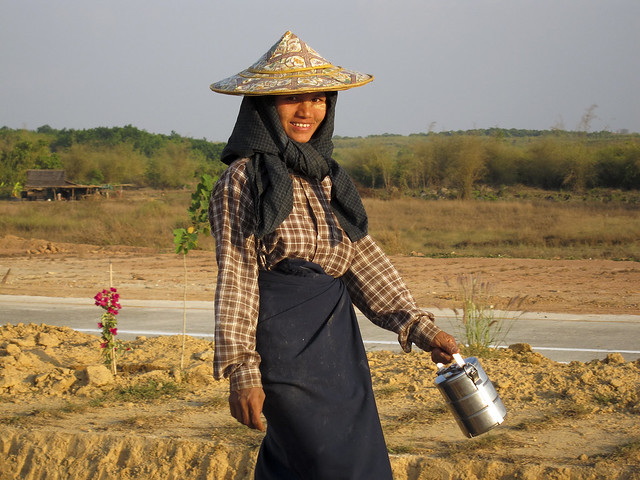Results of World Bank support to Myanmar between January 2013 and January 2021 include:
The National Community-Driven Development Project (NCDDP): Endorsed immediately after reengaging with Myanmar in November 2012, this highly successful project was designed to support a more people-centered and bottom-up approach to development. The project was financed with an $80 million International Development Association (IDA) grant and additional financing of $400 million through an IDA credit. Since 2013, the NCDDP Project has benefitted more than seven million people in 63 townships (20% of the country) and more than 12,000 villages, through the financing of approximately 37,000 sub-projects that improve basic infrastructure and services for transport (roads, bridges, jetties), water, schools, electrification, etc. The NCDDP invested heavily in capacity building and facilitation support for community members who would take direct responsibility for identifying priority development needs and implementing solutions. In the first two years, the project did not operate in conflict areas, but since then more than one-third of project areas have been conflict-affected.
Building on the successful NCDDP, the project’s Contingency Emergency Response Component (CERC) was activated in July 2020 in response to the COVID-19 crisis. Activation allowed transfer of $110 million from NCDDP, divided in a $60 million cash-for-work program and a $50 million Emergency Village Revolving Fund. Cash-for-Work results as of January 1, 2021: Operating in 259 townships and 2,505 villages with an estimated 2.1 million population; 400,781 beneficiary households; 42% female participants; MMK 17 billion in wages paid; 4,402 sub-projects under implementation (mostly roads and water supply). Emergency Village Revolving Fund results as of January 1, 2021: Operating in 247 townships and 1,710 villages; 134,816 revolving loans approved; MMK 41.1 billion disbursed to borrowers; 47% female borrowers
The National Electrification Project (NEP): The Government of Myanmar adopted the National Electrification Plan in 2014 – drawing from World Bank analytical support and expertise through geospatial least-cost electrification planning – to achieve universal access to affordable, reliable and sustainable electricity services for all by 2030. Two-thirds of the population without electricity access belong to over 130 distinct groups, have distinct languages/dialects, are often among the poorest, and reside in the most isolated regions, which compounds the challenges of service delivery. Since its implementation, NEP has successfully provided electricity access to 3.8 million people, half of whom were female beneficiaries, in 12,000 villages in remote rural areas through both grid extension and off-grid solution with 405,000 solar home systems. In addition, the project has provided electricity access to 20,000 schools, rural health clinics and community centers in all these villages. 125,000 streetlights have been installed and been providing safety to the residents. A mobile phone-based Citizen Engagement Platform was successfully established in the pilot phase and was subsequently scaled up in parallel with the increase of solar home system installations.
The Decentralizing Funding to Schools Project (DFSP) in 2019 and 2020 disbursed funds to township education offices, schools, and at-risk children and their families, in which 244,331 students in 57 townships received stipends, all government schools (47,008) and monastic schools (1,500) in 330 townships received school improvement funding, more than 20,000 mentee-teachers in 150 townships benefitted from in-school visit and support from a teacher mentor, six rounds of early learning assessment data were collected, analyzed, and used to inform to design an early reading pilot. The project upholds two underlying principles, which are non-discrimination and inclusive consultation.
The Inclusive Access and Quality Education (IAQE) project extended the geographic scope of the DFSP taking a national and a focused approach, covering all states and regions and supporting programs to reach out to schools across the country, while placing greater emphasis on social inclusion and support to conflict-affected areas. More than 70 percent of the financing has been dedicated to Myanmar’s most disadvantaged townships, with a particular focus on the most under-performing schools and teachers within these townships. The design of the IAQE project also includes support to strengthening the efficiency of the education system, including through improved public financial and human resource management and technical support to the Ministry of Education, and stringent monitoring mechanisms.
The Myanmar Essential Health Services Access Project (EHSAP) since 2015 has supported over 12,000 primary health care facilities across the country, ranging from township hospitals to the sub rural health centers, with monthly health facility funds to improve service delivery readiness of these critical frontline health facilities, thus expanding access to basic essential health services for mothers, newborns and children both at the facility level and within the community. In addition, EHSAP strengthened the quality of care by skills building of frontline health workers – about 9,000 midwives were trained on how to provide emergency care during pregnancy and immediately after birth for mothers and babies, and 4,500 midwives learnt also how to identify and manage common childhood illnesses. At the systems level, EHSAP enhanced supervision practice by improving the regularity and systematic approach of supervision visits, improves efficiency and responsiveness of public finance through financial trainings and supported introduction of tablet-based health management information systems to the midwives.
Funds under EHSAP were in May 2020 also mobilized to assist Myanmar’s response to the COVID-19 pandemic by financing (i) capacity building and operational costs to intensify surveillance activities in all states and regions; (ii) establishment of functioning information and reporting system for all suspected cases; (iii) engagement with basic health staff (BHS) including Ethnic Health Organizations for community surveillance; (iv) dissemination of guidelines to BHS and community volunteers on COVID-19; (v) development and dissemination of Information, Education and Communication materials for risk communication on COVID-19; and (vi) operating expenses at the point of entries.
In April 2020, the World Bank approved a US$50 million IDA credit plus US$7.7 million grant from the Pandemic Emergency Financing Facility for the Myanmar COVID-19 Emergency Response Project to help Myanmar fill a critical gap in its contingency plan to urgently increase hospital preparedness and surge capacity in order to reduce the spread of COVID-19, protect health workers, and treat patients. Eleven central level hospitals and 54 Region and State level hospitals across all Regions and States were prioritized for project support.
The Maternal and Child Cash Transfer Project has provided much needed financial support for people in Myanmar hit by the COVID-19 pandemic. Over 126,600 women (pregnant women and women with children under two years old) in Ayeyarwady Region and Shan State were enrolled in the program by late August 2020. The beneficiaries received 6 months of cash payment, totaling MMK 90,000 (15,000MMK/$11.50 per month). Cash distribution began on September 9, 2020 through private payment agents, (AYA and KBZ banks). By late 2020, 50% of beneficiaries in Shan State and 70% in Ayeyarwady Region had received payments.
In June 2020 the National Food and Agriculture System Project was approved, to support income retention for farmers by improving the quality and utilization of agricultural inputs, generate labor-intensive cash-for work-activities to create jobs for poor households and returning migrants, increase agricultural productivity and diversification, and enhance market access for Myanmar farmers, with a strong focus on inclusion for smallholder farmers, women and other vulnerable groups. The US$200 million project was in its preparatory stage in January 2021.
Updated as of September 2022







